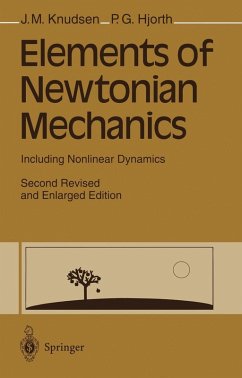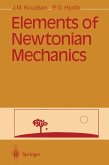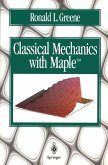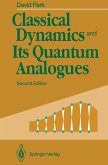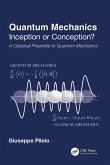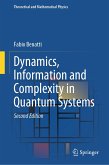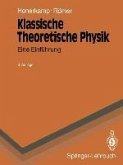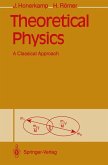Jens M. Knudsen, Poul G. Hjorth
Elements of Newtonian Mechanics (eBook, PDF)
Including Nonlinear Dynamics
68,95 €
inkl. MwSt.
Sofort per Download lieferbar

34 °P sammeln
Jens M. Knudsen, Poul G. Hjorth
Elements of Newtonian Mechanics (eBook, PDF)
Including Nonlinear Dynamics
- Format: PDF
- Merkliste
- Auf die Merkliste
- Bewerten Bewerten
- Teilen
- Produkt teilen
- Produkterinnerung
- Produkterinnerung

Bitte loggen Sie sich zunächst in Ihr Kundenkonto ein oder registrieren Sie sich bei
bücher.de, um das eBook-Abo tolino select nutzen zu können.
Hier können Sie sich einloggen
Hier können Sie sich einloggen
Sie sind bereits eingeloggt. Klicken Sie auf 2. tolino select Abo, um fortzufahren.

Bitte loggen Sie sich zunächst in Ihr Kundenkonto ein oder registrieren Sie sich bei bücher.de, um das eBook-Abo tolino select nutzen zu können.
Structured around the fundamental problem of motion and the concept of inertial frames, this unconventional, award winning presentation provides a thorough one-semester course on Newtonian mechanics. The text is built around a large number of worked examples and contains many interesting problems with solutions. This 2nd, revised edition contains a new chapter on nonlinear dynamics.
- Geräte: PC
- ohne Kopierschutz
- eBook Hilfe
- Größe: 47.74MB
Andere Kunden interessierten sich auch für
![Elements of Newtonian Mechanics (eBook, PDF) Elements of Newtonian Mechanics (eBook, PDF)]() Jens M. KnudsenElements of Newtonian Mechanics (eBook, PDF)62,95 €
Jens M. KnudsenElements of Newtonian Mechanics (eBook, PDF)62,95 €![Classical Mechanics with Maple (eBook, PDF) Classical Mechanics with Maple (eBook, PDF)]() Ronald L. GreeneClassical Mechanics with Maple (eBook, PDF)40,95 €
Ronald L. GreeneClassical Mechanics with Maple (eBook, PDF)40,95 €![Classical Dynamics and Its Quantum Analogues (eBook, PDF) Classical Dynamics and Its Quantum Analogues (eBook, PDF)]() David ParkClassical Dynamics and Its Quantum Analogues (eBook, PDF)88,95 €
David ParkClassical Dynamics and Its Quantum Analogues (eBook, PDF)88,95 €![Quantum Mechanics (eBook, PDF) Quantum Mechanics (eBook, PDF)]() Giuseppe PileioQuantum Mechanics (eBook, PDF)49,95 €
Giuseppe PileioQuantum Mechanics (eBook, PDF)49,95 €![Dynamics, Information and Complexity in Quantum Systems (eBook, PDF) Dynamics, Information and Complexity in Quantum Systems (eBook, PDF)]() Fabio BenattiDynamics, Information and Complexity in Quantum Systems (eBook, PDF)144,95 €
Fabio BenattiDynamics, Information and Complexity in Quantum Systems (eBook, PDF)144,95 €![Klassische Theoretische Physik (eBook, PDF) Klassische Theoretische Physik (eBook, PDF)]() Josef HonerkampKlassische Theoretische Physik (eBook, PDF)24,99 €
Josef HonerkampKlassische Theoretische Physik (eBook, PDF)24,99 €![Theoretical Physics (eBook, PDF) Theoretical Physics (eBook, PDF)]() Josef HonerkampTheoretical Physics (eBook, PDF)72,95 €
Josef HonerkampTheoretical Physics (eBook, PDF)72,95 €-
-
-
Structured around the fundamental problem of motion and the concept of inertial frames, this unconventional, award winning presentation provides a thorough one-semester course on Newtonian mechanics. The text is built around a large number of worked examples and contains many interesting problems with solutions. This 2nd, revised edition contains a new chapter on nonlinear dynamics.
Dieser Download kann aus rechtlichen Gründen nur mit Rechnungsadresse in A, B, BG, CY, CZ, D, DK, EW, E, FIN, F, GR, HR, H, IRL, I, LT, L, LR, M, NL, PL, P, R, S, SLO, SK ausgeliefert werden.
Produktdetails
- Produktdetails
- Verlag: Springer Berlin Heidelberg
- Seitenzahl: 437
- Erscheinungstermin: 6. Dezember 2012
- Englisch
- ISBN-13: 9783642976735
- Artikelnr.: 53106949
- Verlag: Springer Berlin Heidelberg
- Seitenzahl: 437
- Erscheinungstermin: 6. Dezember 2012
- Englisch
- ISBN-13: 9783642976735
- Artikelnr.: 53106949
- Herstellerkennzeichnung Die Herstellerinformationen sind derzeit nicht verfügbar.
1. The Foundation of Classical Mechanics.- 1.1 Principia.- 1.2 Prerequisites for Newton.- 1.3 The Masterpiece.- 1.4 Concluding Remarks.- 1.5 Problems.- 2. Newton's Five Laws.- 2.1 Newton's Laws of Motion.- 2.2 Integration of the Equation of Motion.- 2.3 Problems.- 3. Gravitational and Inertial Mass.- 3.1 Gravitational Mass.- 3.2 Inertial Mass.- 3.3 Proportionality Between Inertial and Gravitational Mass.- 3.4 Newton's Experiment.- 3.5 Problem.- 4. The Galilei Transformation.- 4.1 The Galilei Transformation.- 4.2 Galileo Speaks.- 4.3 Problems.- 5. The Motion of the Earth.- 5.1 Examples.- 5.2 Problems.- 6. Motion in Accelerated Reference Frames.- 6.1 Newton's 2nd Law Within Accelerated Reference Frames.- 6.2 The Equivalence Principle of Mechanics.- 6.3 The Einstein Box.- 6.4 The Centrifugal Force.- 6.5 Tidal Fields.- 6.6 The Coriolis Force.- 6.7 Tidal Forces and Local Inertial Frames.- 6.8 The Foucault Pendulum.- 6.9 Newton's Bucket.- 6.10 Review: Fictitious Forces.- 6.11 Problems.- 7. The Problem of Motion.- 7.1 Kinematic and Dynamic Views of the Problem of Motion.- 7.2 Einstein Speaks.- 7.3 Symmetry.- 7.4 The Symmetry (Invariance) of Newton's 2nd Law.- 7.5 Limited Absolute Space.- 7.6 The Asymmetry (Variance) of Newton's 2nd Law.- 7.7 Critique of the Newtonian View.- 7.8 Concluding Remarks.- 8. Energy.- 8.1 Work and Kinetic Energy.- 8.2 Conservative Force Fields.- 8.3 Central Force Fields.- 8.4 Potential Energy and Conservation of Energy.- 8.5 Calculation of Potential Energy.- 8.6 The Gravitational Field Around a Homogeneous Sphere.- 8.7 Examples.- 8.8 Review: Conservative Forces and Potential Energy.- 8.9 Problems.- 9. The Center-of-Mass Theorem.- 9.1 The Center of Mass.- 9.2 The Center-of-Mass Frame.- 9.3 Examples.- 9.4 Review: Center of Mass andCenter-of-Mass Theorems.- 9.5 Comments on the Conservation Theorems.- 9.6 Problems.- 10. The Angular Momentum Theorem.- 10.1 The Angular Momentum Theorem for a Particle.- 10.2 Conservation of Angular Momentum.- 10.3 Torque and Angular Momentum Around an Axis.- 10.4 The Angular Momentum Theorem for a System of Particles.- 10.5 Center of Gravity.- 10.6 Angular Momentum Around the Center of Mass.- 10.7 Review: Equations of Motion for a System of Particles.- 10.8 Examples of Conservation of Angular Momentum.- 11. Rotation of a Rigid Body.- 11.1 Equations of Motion.- 11.2 The Rotation Vector.- 11.3 Kinetic Energy.- 11.4 An Arbitrary Rigid Body in Rotation Around a Fixed Axis.- 11.5 Calculation of the Moment of Inertia for Simple Bodies.- 11.6 Equation of Motion for a Rigid Body Rotating Around a Fixed Axis.- 11.7 Work and Power in the Rotation of a Rigid Body Around a Fixed Axis.- 11.8 The Angular Momentum Theorem Referred to Various Points.- 11.9 Examples.- 11.10 Review: Linear Motion and Rotation About a Fixed Axis.- 11.11 Problems.- 12. The Laws of Motion.- 12.1 Review: Classical Mechanics.- 12.2 Remarks on the Three Conservation Theorems.- 12.3 Examples.- 12.4 Problems.- 13. The General Motion of a Rigid Body.- 13.1 Inertia in Rotational Motion.- 13.2 The Inertia Tensor.- 13.3 Euler's Equations.- 13.4 Kinetic Energy.- 13.5 Determination of the Principal Coordinate System.- 13.6 Problems.- 14. The Motion of the Planets.- 14.1 Tycho Brahe.- 14.2 Kepler and the Orbit of Mars.- 14.3 Conic Sections.- 14.4 Newton's Law of Gravity Derived from Kepler's Laws.- 14.5 The Kepler Problem.- 14.6 The Effective Potential.- 14.7 The Two-Body Problem.- 14.8 Double Stars: The Motion of the Heliocentric Reference Frame.- 14.9 Review: Kepler Motion.- 14.10 Examples.- 14.11 Problems.-15. Harmonic Oscillators.- 15.1 Small Oscillations.- 15.2 Energy in Harmonic Oscillators.- 15.3 Free Damped Oscillations.- 15.4 Energy in Free, Weakly Damped Oscillations.- 15.5 Forced Oscillations.- 15.6 The Forced Damped Harmonic Oscillator.- 15.7 Frequency Characteristics.- 15.8 Power Absorption.- 15.9 The Q-Value of a Weakly Damped Harmonic Oscillator.- 15.10 The Lorentz Curve.- 15.11 Complex Numbers.- 15.12 Problems.- 16. Remarks on Nonlinearity and Chaos.- 16.1 Determinism vs Predictability.- 16.2 Linear and Nonlinear Differential Equations.- 16.3 Phase Space.- 16.4 A Forced, Damped Nonlinear Oscillator.- 16.5 Liapunov Exponents.- 16.6 Chaos in the Solar System.- 16.7 Problems.- Appendix. Vectors and Vector Calculus.- Selected References.- Answers to Problems.
1. The Foundation of Classical Mechanics.- 1.1 Principia.- 1.2 Prerequisites for Newton.- 1.3 The Masterpiece.- 1.4 Concluding Remarks.- 1.5 Problems.- 2. Newton's Five Laws.- 2.1 Newton's Laws of Motion.- 2.2 Integration of the Equation of Motion.- 2.3 Problems.- 3. Gravitational and Inertial Mass.- 3.1 Gravitational Mass.- 3.2 Inertial Mass.- 3.3 Proportionality Between Inertial and Gravitational Mass.- 3.4 Newton's Experiment.- 3.5 Problem.- 4. The Galilei Transformation.- 4.1 The Galilei Transformation.- 4.2 Galileo Speaks.- 4.3 Problems.- 5. The Motion of the Earth.- 5.1 Examples.- 5.2 Problems.- 6. Motion in Accelerated Reference Frames.- 6.1 Newton's 2nd Law Within Accelerated Reference Frames.- 6.2 The Equivalence Principle of Mechanics.- 6.3 The Einstein Box.- 6.4 The Centrifugal Force.- 6.5 Tidal Fields.- 6.6 The Coriolis Force.- 6.7 Tidal Forces and Local Inertial Frames.- 6.8 The Foucault Pendulum.- 6.9 Newton's Bucket.- 6.10 Review: Fictitious Forces.- 6.11 Problems.- 7. The Problem of Motion.- 7.1 Kinematic and Dynamic Views of the Problem of Motion.- 7.2 Einstein Speaks.- 7.3 Symmetry.- 7.4 The Symmetry (Invariance) of Newton's 2nd Law.- 7.5 Limited Absolute Space.- 7.6 The Asymmetry (Variance) of Newton's 2nd Law.- 7.7 Critique of the Newtonian View.- 7.8 Concluding Remarks.- 8. Energy.- 8.1 Work and Kinetic Energy.- 8.2 Conservative Force Fields.- 8.3 Central Force Fields.- 8.4 Potential Energy and Conservation of Energy.- 8.5 Calculation of Potential Energy.- 8.6 The Gravitational Field Around a Homogeneous Sphere.- 8.7 Examples.- 8.8 Review: Conservative Forces and Potential Energy.- 8.9 Problems.- 9. The Center-of-Mass Theorem.- 9.1 The Center of Mass.- 9.2 The Center-of-Mass Frame.- 9.3 Examples.- 9.4 Review: Center of Mass andCenter-of-Mass Theorems.- 9.5 Comments on the Conservation Theorems.- 9.6 Problems.- 10. The Angular Momentum Theorem.- 10.1 The Angular Momentum Theorem for a Particle.- 10.2 Conservation of Angular Momentum.- 10.3 Torque and Angular Momentum Around an Axis.- 10.4 The Angular Momentum Theorem for a System of Particles.- 10.5 Center of Gravity.- 10.6 Angular Momentum Around the Center of Mass.- 10.7 Review: Equations of Motion for a System of Particles.- 10.8 Examples of Conservation of Angular Momentum.- 11. Rotation of a Rigid Body.- 11.1 Equations of Motion.- 11.2 The Rotation Vector.- 11.3 Kinetic Energy.- 11.4 An Arbitrary Rigid Body in Rotation Around a Fixed Axis.- 11.5 Calculation of the Moment of Inertia for Simple Bodies.- 11.6 Equation of Motion for a Rigid Body Rotating Around a Fixed Axis.- 11.7 Work and Power in the Rotation of a Rigid Body Around a Fixed Axis.- 11.8 The Angular Momentum Theorem Referred to Various Points.- 11.9 Examples.- 11.10 Review: Linear Motion and Rotation About a Fixed Axis.- 11.11 Problems.- 12. The Laws of Motion.- 12.1 Review: Classical Mechanics.- 12.2 Remarks on the Three Conservation Theorems.- 12.3 Examples.- 12.4 Problems.- 13. The General Motion of a Rigid Body.- 13.1 Inertia in Rotational Motion.- 13.2 The Inertia Tensor.- 13.3 Euler's Equations.- 13.4 Kinetic Energy.- 13.5 Determination of the Principal Coordinate System.- 13.6 Problems.- 14. The Motion of the Planets.- 14.1 Tycho Brahe.- 14.2 Kepler and the Orbit of Mars.- 14.3 Conic Sections.- 14.4 Newton's Law of Gravity Derived from Kepler's Laws.- 14.5 The Kepler Problem.- 14.6 The Effective Potential.- 14.7 The Two-Body Problem.- 14.8 Double Stars: The Motion of the Heliocentric Reference Frame.- 14.9 Review: Kepler Motion.- 14.10 Examples.- 14.11 Problems.-15. Harmonic Oscillators.- 15.1 Small Oscillations.- 15.2 Energy in Harmonic Oscillators.- 15.3 Free Damped Oscillations.- 15.4 Energy in Free, Weakly Damped Oscillations.- 15.5 Forced Oscillations.- 15.6 The Forced Damped Harmonic Oscillator.- 15.7 Frequency Characteristics.- 15.8 Power Absorption.- 15.9 The Q-Value of a Weakly Damped Harmonic Oscillator.- 15.10 The Lorentz Curve.- 15.11 Complex Numbers.- 15.12 Problems.- 16. Remarks on Nonlinearity and Chaos.- 16.1 Determinism vs Predictability.- 16.2 Linear and Nonlinear Differential Equations.- 16.3 Phase Space.- 16.4 A Forced, Damped Nonlinear Oscillator.- 16.5 Liapunov Exponents.- 16.6 Chaos in the Solar System.- 16.7 Problems.- Appendix. Vectors and Vector Calculus.- Selected References.- Answers to Problems.
